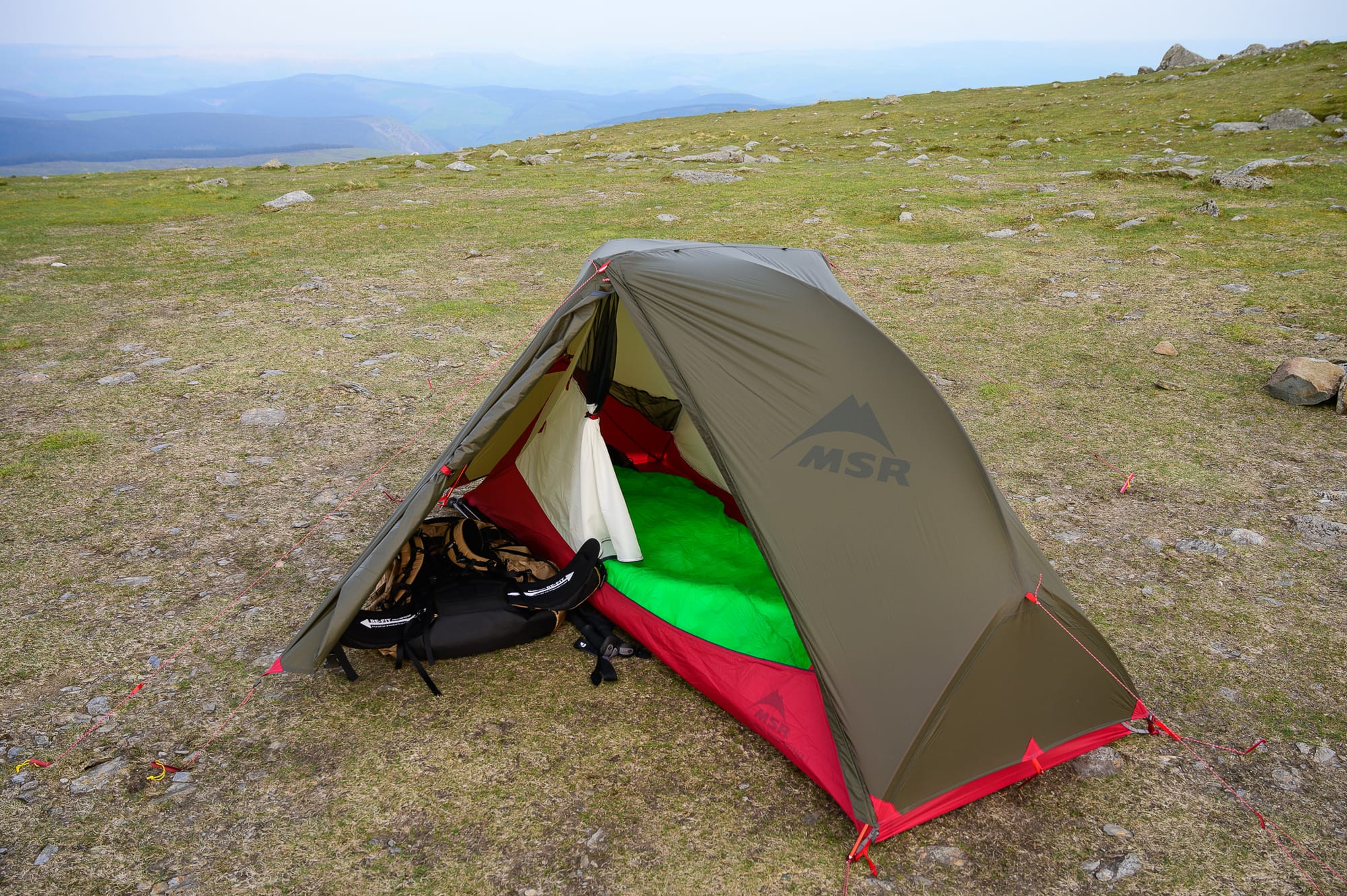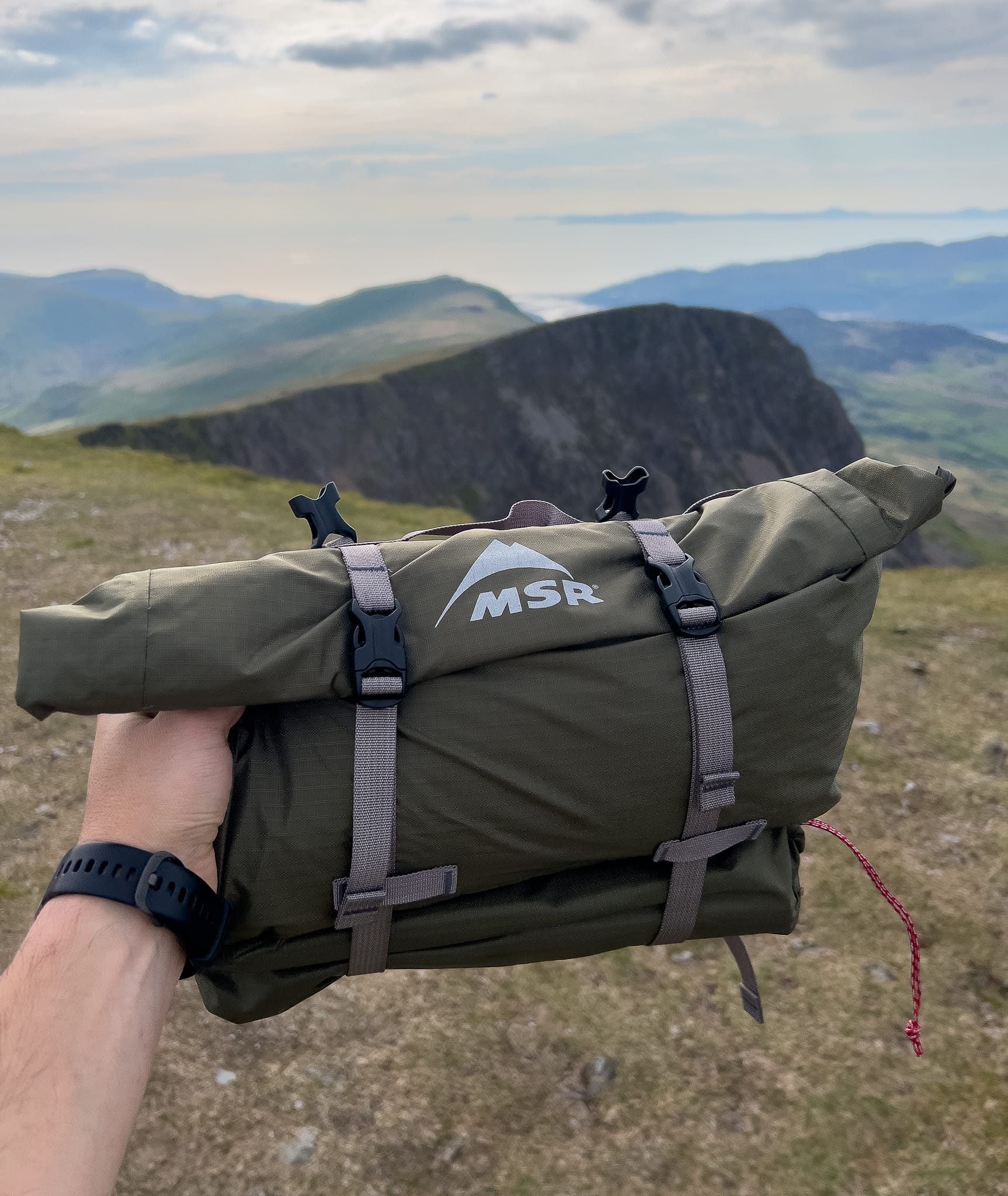When a friend and fellow gear enthusiast mentioned MSR had released a bikepacking version of their long-standing Hubba Hubba tent, I didn’t think much of it at first, as I’m a hiker, not a cyclist. However, my interest was sparked when he suggested it might be well-suited for backpacking, thanks to a few design updates.
Since the original Hubba Hubba launched in 2004, it’s never been the lightest, cheapest, or most durable tent, but it strikes a great balance between all three, which explains why it’s still on the market 20 years later. Having never used a Hubba Hubba before, I was eager to test this latest version and took it on several trips hiking in the mountains.
Key Specs & Features
The three season MSR Hubba Hubba Bikepack 1-Person Tent offers solid technical specifications. Its maximum packed weight, including the waterproof handlebar-mounting bag, is a competitive 1.27 kg, with a compact packed size of 36 x 17 x 11 cm.
Designed specifically for bikepacking, the tent provides exceptional headroom (97 cm), short poles (30 cm), a large internal clothesline, and a spacious vestibule area.
The rainfly, floor, and canopy are all made from 20D nylon ripstop material with a hydrostatic head of 1200 mm. The floor has been made lighter than that of the standard Hubba Hubba, which uses a more durable 30D ripstop nylon and has a hydrostatic head of 3000 mm.
Real world testing
I tested the MSR Hubba Hubba Bikepack 1-Person tent on several hiking trips in the British mountains during summer and autumn, including a summit camp, moderate wind conditions, and both dry and wet weather. Due to the unusually dry weather during my camps, I haven’t yet had the chance to test the tent in a proper rainstorm. On my final trip, I forgot all but a few spare pegs, but I was still able to secure a decent pitch — more on that later.
Impressive head room and packability
On the first night out, I quickly noticed that the headroom and living space were quite generous compared to the solo backpacking tents I typically use. At six feet tall, I can comfortably sit upright and move around without touching the inner walls. I also often find lightweight solo tents a bit cramped in length, but with a length of 216 cm, there is plenty of space to stretch out, even for taller individuals.
As with the usual Hubba Hubba design, the floor is rectangular rather than tapered, unlike many smaller backpacking tents. This provided ample space to store gear inside, keeping my pack and spare clothing dry and off the damp ground. However, like many tents, it would benefit from the option to peg the floor in place. The vestibule is also spacious, offering plenty of room for storage and allowing for cooking in the porch area, something that can often be challenging in solo backpacking tents.
A major advantage for hikers is the redesigned DAC poles, which are short enough to fit horizontally in a backpack. For backpacking, I would skip the durable waterproof handlebar bag, as it adds unnecessary weight, and opt for a lightweight stuff sack instead.
Pitching is a breeze
Pitching the tent is very straightforward. The poles slot into eyelets at each corner of the floor, and the inner tent attaches to the poles with small clips. It takes a maximum of five minutes to pitch, and since it’s a free-standing structure, you don’t need to peg the floor out first, making it easy to move around while you find the ideal spot. Once you attach the rainfly to the eyelets, however, you’ll need to peg out the vestibule and door.
On one trip, I forgot all but three non-MSR spare pegs. I’m not a big fan of the pre-supplied Mini Groundhog pegs, as they can be hard on the hands, and you often don’t get enough of them to secure all the guy lines, which I also found. Despite this, I managed to achieve a stable pitch using rocks and my trekking poles, and the tent remained firm in moderately strong winds throughout the night. That really impressed me. The main drawback, however, is that you must pitch the inner tent first, which increases the risk of it getting wet if you’re setting up in rainy conditions. This design isn’t surprising, as it’s a three-season tent, likely designed with the American market in mind, rather than the often unpredictable weather of the British mountains.

Not just for bikepacking
Other features worth noting include the inability to pitch the flysheet all the way to the ground at the ends of the tent. While this allows for good ventilation, it may also let in more wind-blown weather. That said, ventilation options are plentiful, with built-in vents at each end, and much of the inner tent is made of mesh. You can also roll up and secure both the inner and outer doors in fine weather, though I wish MSR had added a second toggle to allow the entire door to be rolled up tightly, preventing it from flapping in the wind.
Speaking of wind, I tested the tent in moderately strong gusts (around 20-25 mph) without any issues except some deforming of the structure. I wouldn’t however recommend using it in exposed mountain areas, or when strong winds are forecast. In terms of rain, some fellow gear enthusiasts have expressed concerns about the thin groundsheet, with its 1200 mm hydrostatic head. While you can see some moisture under pressure, I didn’t encounter any issues when pitching on wet ground.
While the Hubba Hubba Bikepack 1 has some drawbacks, it also has many strengths and is well-suited to backpacking. It’s spacious, packs down small, is easy to pitch, and is surprisingly durable given its lightweight materials. A standout feature for me was the shorter poles—this innovative tweak makes the tent far more packable, a feature I’d love to see in more solo backpacking tents.

Summary
Despite a few drawbacks, the MSR Hubba Hubba Bikepack 1-Person Tent’s impressive balance of weight, space, and durability make it an excellent choice for both backpacking and bikepacking adventures.
While the necessity of pitching the inner tent first could be a concern in wet weather, its generous headroom and floor space, innovative shorter poles, and ample ventilation options enhance its usability. I may choose to forgo the waterproof handlebar bag for a lighter pack in the future, but its compact packed size and ease of setup ensure I will continue to rely on it for three season camping in future.
About MSR
Mountain Safety Research (MSR) is a Seattle-based outdoor equipment company founded in 1969 by Larry Penberthy, a passionate mountaineer and engineer. Originally focused on improving the safety and reliability of climbing gear, MSR quickly expanded its product line to include high-performance camping and backpacking equipment, such as stoves, tents, water filters, and snowshoes. Known for its innovation and commitment to quality, MSR blends cutting-edge technology with practical design, making its gear highly regarded among outdoor enthusiasts for its durability, functionality, and reliability in challenging conditions.
